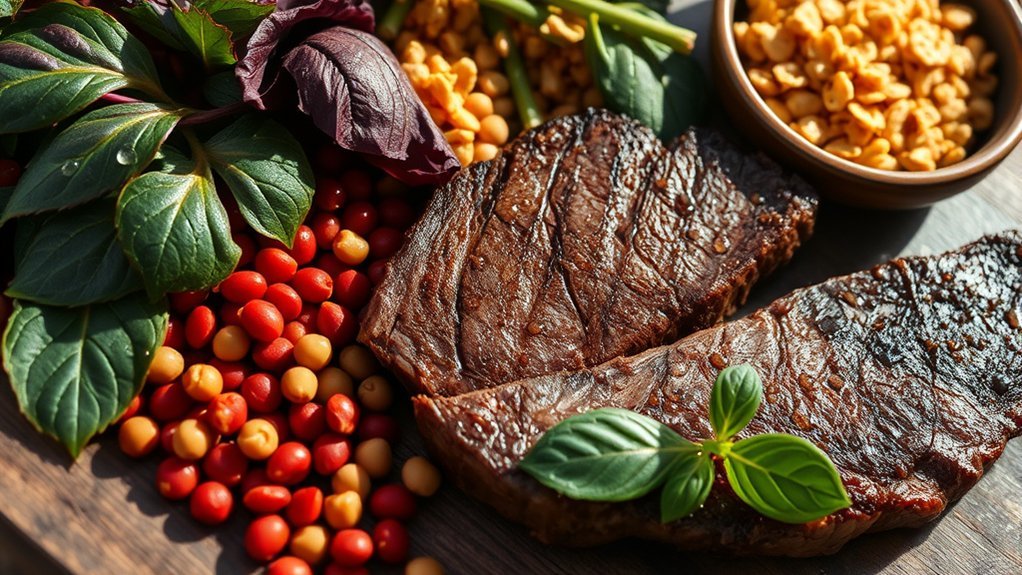Iron plays an essential role in your overall health, influencing everything from energy levels to immune function. It’s important to understand the different types of iron and how to incorporate them into your diet effectively. By focusing on both heme and non-heme iron sources, you can optimize your intake. But how do you guarantee that your body absorbs this fundamental mineral efficiently? Let’s explore the best strategies to enhance your iron consumption.
Understanding Iron: Types and Functions
When you think about nutrition, understanding iron’s types and functions is crucial for maintaining your health. Iron exists mainly in two forms: heme and non-heme. Heme iron, found in animal products, is more readily absorbed by your body. Non-heme iron, present in plant-based foods, requires vitamin C for ideal absorption. Iron plays critical roles in your body, including transporting oxygen in red blood cells and supporting metabolic processes. It’s essential for energy production and immune function. A deficiency can lead to anemia, fatigue, and weakened immunity. To maintain adequate iron levels, focus on a balanced diet that includes a mix of heme and non-heme sources, along with foods rich in vitamin C to enhance absorption.
Top Animal Sources of Iron
Animal sources of iron provide some of the most bioavailable forms of this essential nutrient, particularly heme iron, which your body absorbs more efficiently than non-heme iron. Among the top sources are red meats, such as beef and lamb, which are rich in heme iron. Poultry, like chicken and turkey, also contains significant amounts, though slightly less than red meat. Fish, especially tuna and salmon, is another excellent option. Organ meats, particularly liver, stand out as one of the richest sources of iron. Eggs, while lower in iron, still contribute to your intake. Including these animal sources in your diet can help maintain ideal iron levels, supporting energy, metabolism, and overall health.
Best Plant-Based Iron Sources
While animal sources are well-known for their iron content, plant-based foods also offer valuable options for those seeking to boost their iron intake. Incorporating a variety of these foods into your diet can help meet your nutritional needs effectively. Here are some of the best plant-based iron sources:
| Food Item | Iron Content (mg per 100g) | Serving Suggestions |
|---|---|---|
| Lentils | 3.3 | In soups or salads |
| Spinach | 2.7 | Sautéed or in smoothies |
| Chickpeas | 2.9 | Hummus or stews |
| Quinoa | 1.5 | As a base for bowls |
Incorporating these foods can enhance your overall iron intake while providing essential nutrients.
Tips for Enhancing Iron Absorption
To maximize the benefits of plant-based iron sources, it’s important to contemplate how to enhance iron absorption in your body. First, pair iron-rich foods with vitamin C sources, like citrus fruits or bell peppers, as this can greatly improve absorption. Avoid consuming calcium-rich foods or supplements alongside your iron sources, since calcium competes for absorption. Also, limit your intake of tannins found in tea and coffee during meals, as they can inhibit iron absorption. Finally, consider soaking, sprouting, or fermenting grains and legumes, which can reduce phytate levels that hinder iron uptake. By implementing these strategies, you’ll optimize the iron your body can absorb, ensuring you meet your nutritional needs effectively.
Meal Ideas to Boost Iron Intake
Iron-rich meals can greatly contribute to your overall health and energy levels. Incorporating various iron sources into your diet can help you meet your nutritional needs. Here are some meal ideas to boost your iron intake:
Incorporating iron-rich meals into your diet can enhance your health and energy levels significantly.
- Spinach and lentil salad: Toss fresh spinach with cooked lentils, cherry tomatoes, and a lemon vinaigrette.
- Beef stir-fry: Sauté lean beef strips with bell peppers, broccoli, and garlic, served over brown rice.
- Quinoa bowl: Combine quinoa with black beans, avocado, and diced tomatoes for a nutritious meal.
- Chickpea curry: Cook chickpeas with coconut milk, spinach, and spices, served with whole grain bread.
- Tofu scramble: Sauté crumbled tofu with kale, onions, and nutritional yeast for a hearty breakfast.
These meals not only taste great but also provide essential iron.
Frequently Asked Questions
What Are the Symptoms of Iron Deficiency?
You might experience fatigue, weakness, pale skin, shortness of breath, dizziness, or cold hands and feet if you’re iron deficient. These symptoms occur because your body lacks the necessary iron to produce adequate red blood cells.
Can I Take Iron Supplements With Food?
Yes, you can take iron supplements with food. However, certain foods, especially dairy and high-calcium items, may hinder absorption. It’s best to consult your healthcare provider for personalized advice on timing and dietary considerations.
How Much Iron Do I Need Daily?
You need about 8 mg of iron daily if you’re a man, and 18 mg if you’re a woman. Pregnant women require about 27 mg. Adjust your intake based on age, health, and dietary needs.
Are There Any Side Effects of Iron Supplements?
Yes, iron supplements can cause side effects like constipation, nausea, and stomach upset. You might experience dark stools too. It’s crucial to consult your healthcare provider before starting any supplement to manage potential risks effectively.
Can Cooking in Cast Iron Increase Dietary Iron?
Yes, cooking in cast iron can increase dietary iron. When acidic foods are prepared, they absorb small amounts of iron from the cookware, potentially enhancing your iron intake, particularly beneficial for individuals with higher iron needs.
Conclusion
Incorporating iron-rich foods into your diet is essential for maintaining ideal health. Did you know that nearly 25% of the world’s population is affected by iron deficiency? By focusing on heme iron from animal sources and enriching your meals with non-heme iron from plants, you can greatly improve your iron levels. Remember to pair these foods with vitamin C to enhance absorption, creating a balanced and healthful approach to iron intake that supports your overall well-being.
